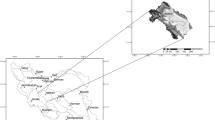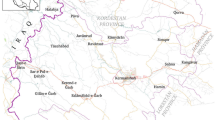Abstract
Groundwater flow and contaminant transport simulations require the determination of various hydro geological parameters such as transmissivity, aquifer thickness, seepage velocity, dispersibility etc. Due to the complex behavior of Groundwater flow and contaminant transport simulations, reliable measurement of the parameters involved is often not possible while performing groundwater system simulations. Hence a methodology is developed in this study wherein a neural-fuzzy model based on an Adaptive Neuro Fuzzy Inference System (ANFIS) is integrated with the particle swarm optimization to estimate the uncertainties in output parameters due to imprecision in input parameters. The Particle Swarm Optimization (PSO) technique is used to find a global optimal solution to a groundwater flow and contaminant transport problem. This is achieved by incorporating the Adaptive Neuro Fuzzy Inference System (ANFIS) to evaluate the objective function within the PSO framework. Later, the ANFIS-PSO algorithm is applied to four problems taking a) a single imprecise parameter for radial flow to a well, b) two imprecise parameters for one dimensional solute transport in steady uniform flow, c) three imprecise parameters for a two-dimensional heterogeneous steady flow problem and finally d) four imprecise parameters for the problem of two-dimensional solute transport. The results show that with the ANFIS-PSO algorithm, the computational burden is reduced considerably when compared to the commonly used vertex method.
Similar content being viewed by others
References
Angeline (1998). “Using selection to improve particle swarm optimization.” Evolutionary Computation Proceedings, 1998, IEEE World Congress on Computational Intelligence, pp. 84–89.
Bedient, P. B., Rifai, H. S., and Newell, C. J. (1999). Groundwater contamination: transport and remediation, Prantice-Hall, Inc., NJ.
Carrera, J. and Neuman, S. (1986). “Estimation of aquifer parameters under transient and steady state conditions: 1. Maximum likelihood method incorporating prior information.” Water Resources Research WRERAO, Vol. 22, No. 2, pp. 199–210.
Chang, L. and Chang, F. (2001). “Intelligent control for modeling of real-time reservoir operation.” Hydrological Processes, Vol. 15, No. 9, pp. 1621–1634.
Chang, F. and Chang, Y. (2006). “Adaptive neuro-fuzzy inference system for prediction of water level in reservoir.” Advances in Water Resources, Vol. 29, No. 1, pp. 1–10.
Deutsch, C. and Journel, A. (1992). GSLIB: Geostatistical software library and user’s guide, Oxford University Press, New York, p. 340.
Dong, C. and Lepowsky, J. (1993). Generalized vertex algebras and relative vertex operators, Birkhauser.
Dong, W. and Shah, H. C. (1987). “Vertex methods for computing functions of fuzzy variables.” Fuzzy Sets Syst., Vol. 24, No. 1, pp. 65–78.
Dou, C., Woldt, W., Bogardi, I., and Dahab, M. (1995). “Steady state groundwater flow simulation with imprecise parameters.” Water Resour. Res., Vol. 31, No. 11, pp. 2709–2719.
Dou, C., Woldt, W., Bogardi, I., and Dahab, M. (1997). “Numerical solute transport simulation using fuzzy sets approach.” J. Contam. Hydro., Vol. 27, Nos. 1–2, pp. 107–126.
Freeze, R., Massmann, J., Smith, L., Sperling, T., and James, B. (1990). “Hydrogeological decision analysis: 1. A framework.” Ground Water, Vol. 28, No. 5, pp. 738–766.
Guan, J. and Aral, M. M. (2004). “Optimal design of groundwater remediation systems using fuzzy set theory.” Water Resour. Res., Vol. 40, W01518, doi:10.1029/2003WR002121.
Guan, J. and Aral, M. M. (2005). “Remediation system design with multiple uncertain parameters using fuzzy sets and genetic algorithm.” J. Hydrol. Eng., Vol. 10, No. 5, pp. 386–394.
Jang, J. (1993). “ANFIS: Adaptive-network-based fuzzy inference system.” Systems, Man and Cybernetics, IEEE Transactions on, Vol. 23, No. 3, pp. 665–685.
Jayabharata Reddy, M. and Mohanta, D. (2007). “A wavelet-fuzzy combined approach for classification and location of transmission line faults.” International Journal of Electrical Power and Energy Systems, Vol. 29, No. 9, pp. 669–678.
Kaufmann, A. and Gupta, M. M. (1991). Introduction to fuzzy arithmetic: Theory and applications, Van Nostrand Reinhold, New York.
Kennedy, J. and Eberhart, R. (1995). “Particle swarm optimization.” Neural Networks, 1995. Proceedings, IEEE International Conference on, p. 4.
Revelli, R. and Ridolfi, L. (2002). “Fuzzy approach for analysis of pipe network.” J. Hydraul. Eng., Vol. 128, No. 1, pp. 93–101.
Ross, T. J. (1995). Fuzzy logic with engineering applications, McGraw-Hill, New York.
Sauty, J. (1980). “An analysis of hydrodispersive transfer in aquifers.” Water Resources Research, Vol. 16, No. 1, pp. 145–158.
Shi, Y. and Eberhart, R. (1998a). “A modified particle swarm optimizer.” Evolutionary Computation Proceedings, 1998. IEEE World Congress on Computational Intelligence, pp. 69–73.
Shi, Y. and Eberhart, R. (1998b). “Parameter selection in particle swarm optimization.” Evolutionary Programming VII, Springer, pp. 591–600.
Takagi, T. and Sugeno, M. (1985). “Fuzzy identification of systems and its applications to modeling and control.” IEEE Transactions on Systems, Man, and Cybernetics, Vol. 15, No. 1, pp. 116–132.
Wang, H. F. and Anderson, M. P. (1982). Introduction to goundwater modeling: Finite difference and finite element methods, W. H. Freeman, San Francisco, Calif.
Zadeh, L. A. (1965). “Fuzzy sets.” Inf. Control, Vol. 8, No. 3, pp. 338–353.
Author information
Authors and Affiliations
Corresponding author
Rights and permissions
About this article
Cite this article
Ch, S., Mathur, S. Modeling uncertainty analysis in flow and solute transport model using Adaptive Neuro Fuzzy Inference System and particle swarm optimization. KSCE J Civ Eng 14, 941–951 (2010). https://doi.org/10.1007/s12205-010-0865-2
Received:
Accepted:
Published:
Issue Date:
DOI: https://doi.org/10.1007/s12205-010-0865-2




